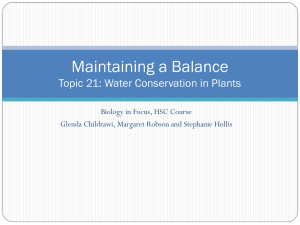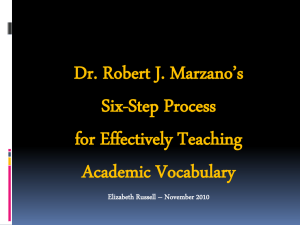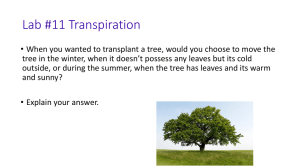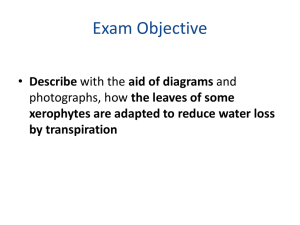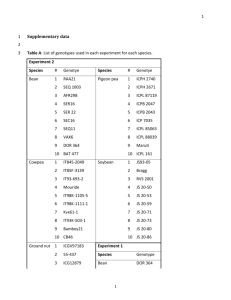Transpiration - onlinebiosurgery
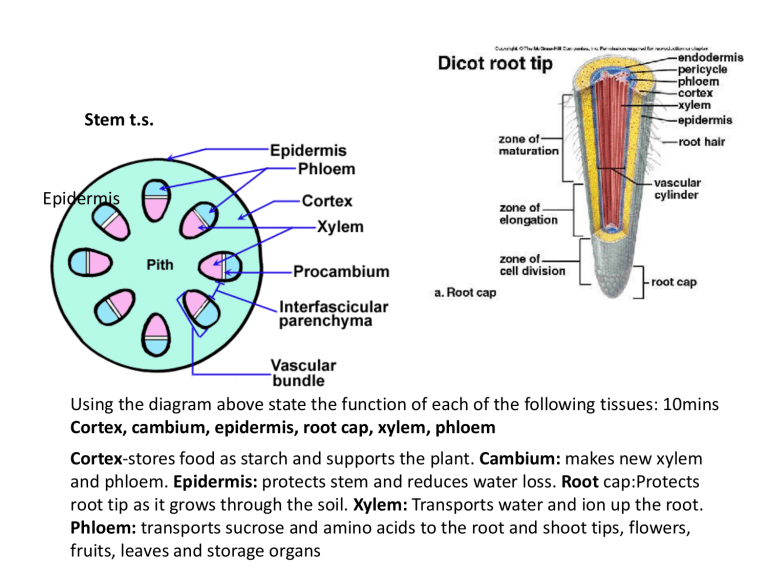
Stem t.s.
Epidermis
Using the diagram above state the function of each of the following tissues: 10mins
Cortex, cambium, epidermis, root cap, xylem, phloem
Cortex-stores food as starch and supports the plant. Cambium: makes new xylem and phloem. Epidermis: protects stem and reduces water loss. Root cap:Protects root tip as it grows through the soil. Xylem: Transports water and ion up the root.
Phloem: transports sucrose and amino acids to the root and shoot tips, flowers, fruits, leaves and storage organs
Transpiration
Objectives:
*Define transpiration in relation to cell surfaces, air spaces and stomata.
**Explain the effects of variation of temperature, humidity and light intensity on transpiration rate.
*** Explain how wilting occurs
Keywords: Throughout the text they are highlighted in different colours
How do tall trees get enough water?
Redwoods are the tallest species of tree in the world.
The tallest redwood ever measured was 120 metres tall. That is six times the height of the
Angel of the North!
How does a plant this size get water from its roots to the branches at the top?
The water will travel up the stem, or trunk, of the tree.
What experiment could show that water travels up stems?
Transpiration
What is transpiration?
Transpiration is the loss of water by evaporation from plants.
Plants lose water when they open the stomata in the leaves to let in carbon dioxide.
Water always moves from an area of high concentration to an area of low concentration. In other words it passes down the water potential gradient. This movement of water is a type of diffusion called osmosis .
High water potential in soil solution to low water potential in root hair cells to lower water potential in cortex to even lower water potential in xylem.
Air around the plant usually contains less water than the cells of the plant, so water evaporates into the air as
water vapour by diffusion.
Although it may seem bad for plants, transpiration actually moves water from the roots to the top of the plant, without using energy. How does this work?
Use the word pull
The water is pulled up by transpiration pull. This mas flow of water depends on two properties of water
Cohesion : the water molecules tend to attract each other, sticking together
Adhesion : the water molecules tend to stick to the inside of the xylem vessel
So there is a continuous flow of water up the xylem vessel. This movement is called transpiration stream
Is the rate of transpiration constant?
Transpiration is a bit like a straw, pulling water up the plant.
Sometimes the pulling force will be stronger and the plant will lose more water.
The speed at which a plant loses water is called the rate of
transpiration. This varies depending on the plant’s environment.
What environmental factors will affect the rate of transpiration?
humidity (amount of moisture in the air)
light intensity
temperature
air movement (wind).
Draw three separate graphs showing change in rate of transpiration with change in humidity, temperature and wind speed
?
?
Why does transpiration vary?
How is the rate of transpiration measured?
Transpiration can be measured using a potometer .
A cut plant stem is sealed into the potometer using a rubber bung.
An air bubble is introduced to the capillary tube.
The distance the bubble travels shows how much water the stem has taken up.
This gives an indirect measurement of the rate of transpiration.
Wilting
What position are stomata in during the day?Why?
More transpiration takes place during the day. Why?
Stomata close up during day or night depending on the condition of the surrounding, Why?
If the plant still does not get enough water what will be the condition of the cell? Turgid /flaccid
If the cells are turgid they give support to the plant to be upright but if they are flaccid they become soft. This condition is called wilting.
Adaptations of plants to different environments
Objectives:
* Draw adaptations of plants in different conditions
* *Describe the adaptations of the leaf, stem and root to different environments, with emphasis on local examples.
*** Explain how the structures help them survive
(when asked to explain an adaptation always give the adaptation e.g. air space in hydrophytes and explain how it is useful)
Keywords:
Xerophytes, hydrophytes, mesophytes
Transpiration – true or false?
Structural and behavioural adaptations of
Xerophytes, such as cacti, usually have special means (storage tissues) of storing and conserving water in their stems. They often have few or no leaves, thick cuticle which reduces transpiration, shiny surfaces to reflect heat and light. Often their stomata
close during the day and absorb CO
2
at night and store it for the day. Photosynthesis occurs in the outer layer of cells in their stems. Many have round compact shape to reduce surface area.
Some plants have adapted to arid environments by growing extremely long roots, allowing them to acquire moisture at or near the water table.
Other desert plants, using behavioural adaptations, have developed a lifestyle in conformance with the seasons of greatest moisture and/or coolest temperatures.
Desert perennials often survive by remaining dormant during dry periods of the year, then springing to life when water becomes available.
Hydrophytes do not need much transport tissue as they are buoyed up in water. They have extensive air spaces in stems and leaves to store CO
2 and O
2 which diffuse very slowly in water than in air. The air spaces also help with buoyancy which keeps the plants close to the light.
Roots have no root hairs as they are only used for anchorage. No cuticle on leaves and stems since there is no need to conserve water.
Mesophytes are terrestrial plants with enough water supply so do not need extreme adaptations e.g. many garden plants.
Examine the different plant specimens describe their adaptations and identify the group they belong to.



